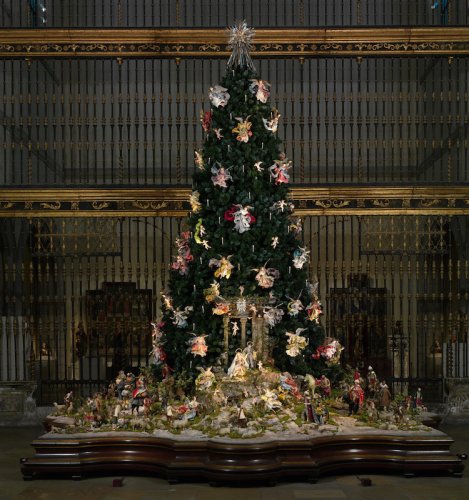The Met continues a longstanding holiday tradition with its annual Christmas tree and historic Creche.
The magnificently lit, twenty-foot blue spruce is decorated with silk-robed angels, and an eighteenth-century Neapolitan Nativity scene of lifelike figures representing the multicultural population of the Mediterranean harbor town.
The theatrical scene is enhanced by an assortment of animals including sheep, goats, horses, a camel, and an elephant, and by background pieces including the ruins of a Roman temple, several quaint houses, and a typical Italian fountain with a lion’s-mask waterspout.
The installation is set in front of the eighteenth-century Spanish choir screen from the Cathedral of Valladolid in the Museum’s Medieval Sculpture Hall.
Unlike past years, there is no formal tree-lighting ceremony in 2021. The tree is being lit on Thanksgiving Day, and will stay lit until January 6th.
Viewing is FREE with museum admission.
See also the traditional Origami Tree at the Museum of Natural History.
See our complete list of Christmas tree and Hanukkah menorah lightings in 2021.
More about the Met’s Christmas Tree and Creche
The tree, glowing with light, is adorned with cherubs and some fifty gracefully suspended angels.
The landscape at the base displays the figures and scenery of the Neapolitan Christmas crib.
This display mingles the three basic elements traditional in eighteenth-century Naples:
Rhe Nativity, with adoring shepherds and their flocks; the procession of the three Magi and their exotically dressed retinue of Asians and Africans; and, most distinctively, a crowd of colorful townspeople and peasants.
The theatrical scene is enhanced by a charming assortment of animals—sheep, goats, horses, a camel, and an elephant—and by background pieces serving as the dramatic setting for the Nativity, including the ruins of a Roman temple, several quaint houses, and a typical Italian fountain with a lion’s-mask waterspout.
Read more detail on the Met’s website.


What do you think about this? We welcome your comments.